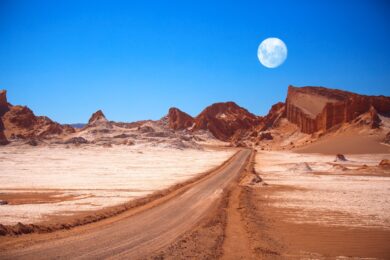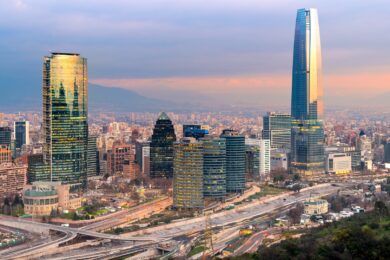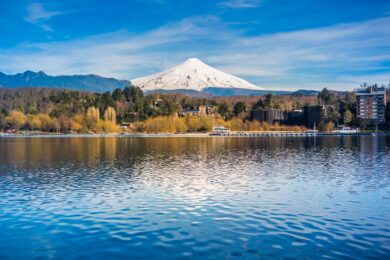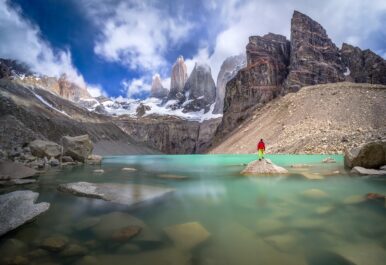Chile
A long, narrow strip of land stretching nearly 2,670 miles (4,300 kilometers) from its northern border with Peru to its southern tip near Antarctica, Chile is one of the most breathtakingly beautiful countries in the world. The country can be divided into five regions, each with diverse geographies and cultures:
1. Northern Chile & The Atacama Desert – Characterized by its arid desert landscapes, this region is home to the Atacama, the driest desert on Earth, where some areas receive less than 0.04 inches (1 millimeter) of rainfall per year. The Atacama is known for some of the most unique landscapes on Earth including the Valle de La Luna (Valley of the Moon), with its lunar like craters and sand dunes, the Salar de Atacama salt flats, the breathtaking Chaxa, Miscanti and Miniques lagoons, which are surrounded by snow capped volcanoes, and the El Tatio geysers. Northern Chile is also known for one of the most unique sculptures in the world, the Hand of the Desert, the mining of copper, lithium and other minerals, and for ancient archaeological sites near Arica, including prehistoric geoglyphs and the world’s oldest known mummies.
2. Central Chile – Home to Santiago, the multi-faceted capital of Chile, several world-class wine growing regions like the Casablanca and Maipo valleys, and Valparaiso, a UNESCO World Heritage Site known for its unique architecture, vibrant street art, historical significance, and picturesque setting along the Pacific Ocean, Central Chile offers visitors a diverse array of experiences.
3. The Lake District – In stark contrast to northern Chile, the Lake district in southern Chile is blessed with rolling hills, lush, green forests, and a multitude of beautiful lakes including Lake Villarrica, Lake Panguipulli, Lake Ranco, and Lake Llanquihue, the second-largest natural lake in South America. The Lake District is also known for its volcanic activity, with several active and dormant volcanoes dotting the landscape. One of the most famous ones is Villarrica Volcano, a popular destination for hiking and skiing during the winter months. In addition to its natural beauty, the Lake District has several picturesque towns including Puerto Varas, Pucón, Valdivia, Osorno, and Villarrica, and various indigenous communities, including the Mapuche people.
4. Chilean Patagonia – One half of one of the most stunningly beautiful regions on the planet (the other half being Argentinian Patagonia), Chilean Patagonia is home to Torres del Paine National Park, which is renowned for its jagged peaks, glaciers, turquoise lakes, diverse wildlife, and some of the most iconic trekking routes in the world. Chilean Patagonia is also known for its intricate network of fjords and channels, the archipelago of Tierra del Fuego (shared with Argentina), which is often referred to as the “end of the world,” and Cape Horn, located at the southern tip of the continent. The region is rich in wildlife, with opportunities to spot guanacos, foxes, pumas, condors, and various bird species. It’s a paradise for birdwatchers and nature photographers. There are also several indigenous people who inhabit the region including the Yaghan and Kawéskar peoples.
5. Easter Island – Known as Rapa Nui in the local Polynesian language, Easter Island is a remote island located in the southeastern Pacific Ocean. The island is renowned for its mysterious and awe-inspiring archaeological sites, particularly the massive stone statues known as Moai, which were carved from single blocks of stone made of compressed volcanic ash called tuff, sometime between the 13th and 16th centuries. These statues can reach heights of up to 33 feet (10 meters) and weigh several tons each. How these statues were moved around various sites on the island and raised to sit on vast stone platforms called ahu, remains a mystery till today. The Rapa Nui people, Polynesian explorers who are believed to have settled the island in the 13th century, have a rich cultural heritage that includes music, dance, and traditional ceremonies. The island was not visited by Europeans until 1722 when Dutch explorer Jacob Roggeveen arrived on Easter Sunday, giving the island its name.
With its diverse mix of landscapes, cultures, cuisines and adventure activities, Chile will have your heart beating faster, wherever you go!
Destinations
Key sights to see
Map
Add to current board
- My Board
- Ali Thursday Test
- Our 2nd Board Test
- third board
- Africa
- My Board
- Paris
- My Board
- My Board
- My Board
- My Board
- My Board
- My Board
- fhjm
- gfdg
- Europe
- Atacama
- London
- Cape Town
- Europe Trip
- Chile Trip
- Easter Island
- Zimbabwe
- My Trip
- Ghana
- My Board
- Test
- Test test1
- Argentina
- Ecuador and the Galapagos
- Italy
- My Board
- my trip
- My Board
- My Board
- My Board
- My Board
- My Board
- My Board
- Botswana
- My Board
- Beaches
- My Board
- Patagonia
- My Board
- My first board
- My Board
- My Board
- Greece
- My Board
- My Board
- Iberian Peninsula
- My Board
- Athens
- My Board
- My Board
- My Board
- My Board
- Ecuador
- My Board
- Argentina
- Argentina Dec21
- Argentina Dec21
- My Board
- My Board
- Turkey
- My Board
- Greece
- My Board
- My Board
- My Board
- Dominican Republic
- My Board
- Patagonia – 2023
- My Board
- My Board
- My Board
- My Board
- My Board
- My Board
- My Board
- My Board
- My Board
- My Board
- My Board
- My Board
- My Board
- My Board
- My Board
- My Board
- My Board
- My Board
- My Board
- My Board
- My Board
- My Board
- My Board
- My Board
- My Board
Add to favorite
Your new board is ready, add more of your favorite places, activities, countries and accommodations



